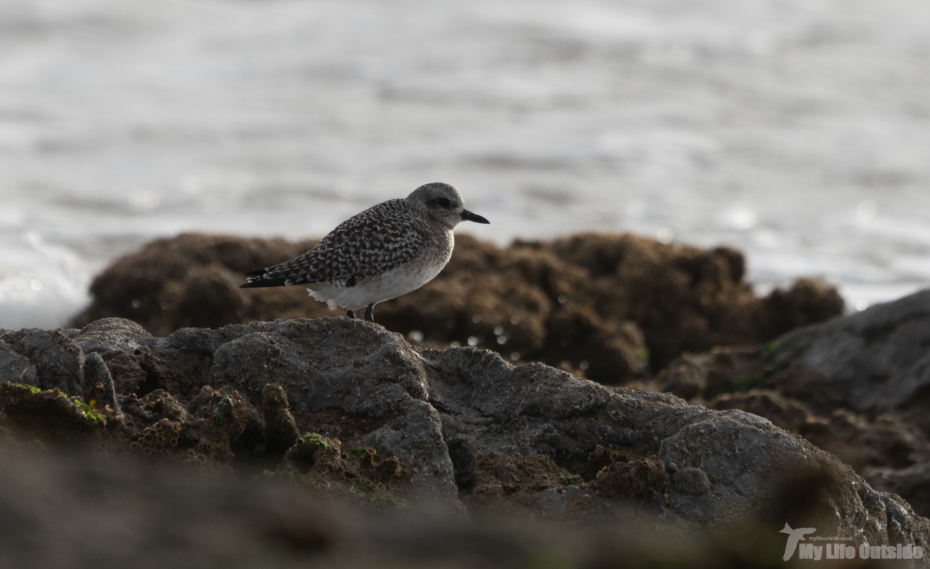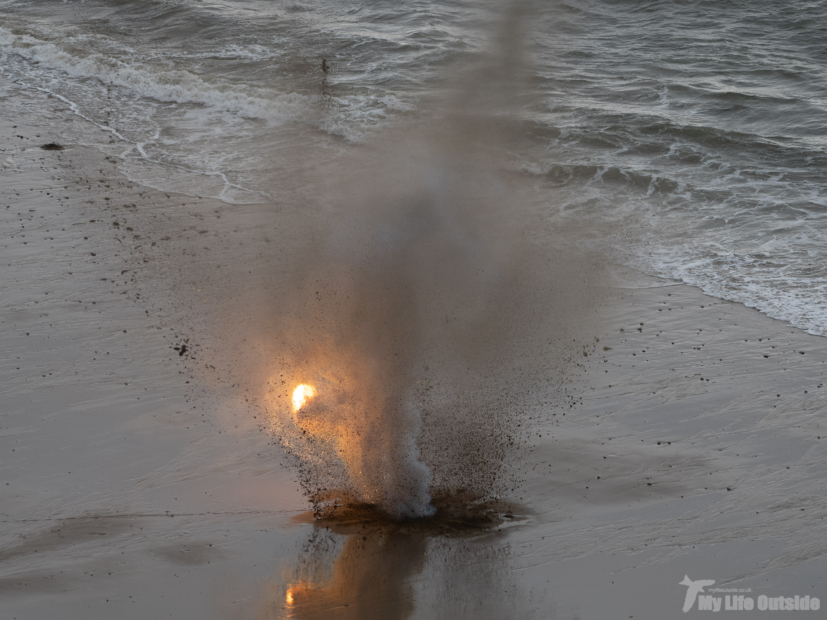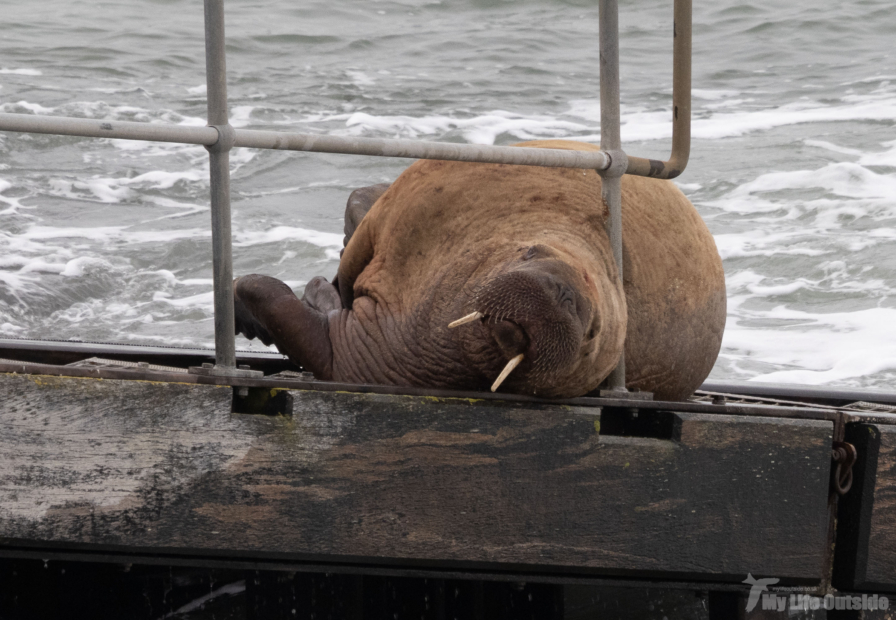Having spent a week in the wilderness of Mull it was something of a shock to return to an office environment and the daily grind. A few low days unsurprisingly followed but its hard to stay down for long with Gower right on our doorstep. Eager to get back out into the countryside we popped over to Arthur’s Stone last Saturday to begin our ‘Gower Loop’ walk. I’ve featured this route on the blog a couple of times previously and it always manages to turn up something unexpected like the snake carrying Buzzard from last year. We started off on more familiar territory though with a pair of Wheatears a little way down from the trig point. Despite being surrounded by these on Mull they are a still a special bird to see, especially considering the much lower numbers that we are treated to here in Wales.
Heading down into Little Reynoldston a Skylark could be seen and most definitely heard high in the sky above us whilst a trio of Linnets were moving rapidly through the Gorse. Willow Warblers, Meadow Pipits and Dunnocks all added their voices to the symphony with an occasional interjection from a passing Swallow, several of which were repeatedly entering and leaving an impressive looking outbuilding. That’s one species I would definitely like to see nesting at our own house. On the grass Rooks and Jackdaws were sharing their feeding grounds with a family of Blackbirds which included two very well developed fledglings. Other signs of successful breeding were not far away in the shape of at least one young Stonechat which was begging for food and being fed by a parent. In fact it seemed that Stonechats were doing particularly well in the area with at least six separate individuals seen.
The small lane leading to Millwood was alive with birds including five Mistle Thrushes that shot up from a neighbouring field as we passed by. My instinct was to follow them for some better views but the appearance of my first two Whitethroats of the year soon put that idea to bed. Despite singing well they unfortunately never showed long enough for me to get my camera onto them, tending instead to move through the centre of bushes and trees. It was great to see them back on territory though and reminded me just how quiet and sparsely populated places can be without our summer migrants. It was while looking for a Whitethroat and the source of another unidentified call (I suspect chicks in nest given it’s high pitched nature) that we stumbled across this great example of Jelly Ear Fungi.
Upon entering Millwood itself we were immediately greeted by a Green Woodpecker flying across the path, closely followed by what looked to be a Great Spotted Woodpecker a little further in. Both nice species to see but our attention was quickly taken by a Marsh Tit hopping around the lower branches of a tree to our right. The tree in question was exactly the same one upon which we’d seen a Marsh Tit last year, suggesting perhaps that this could be a permanent territory. Unfortunately it didn’t treat us to any outbursts of song but said tree has definitely been added to my list of “must visit” places for each spring. Other birds seen in the forest included Jay, Goldcrest, Song Thrush and two Coal Tits along with a definite sighting of the suspected Great Spotted Woodpecker from earlier (it turned out to be a female).
The warm, still air was perhaps deceptive after the horrendous conditions that this part of the country had endured during our time away, but a large tree that had pretty much demolished a small footbridge served as a stark reminder of what we’d missed. I decided that the best way to pass was by going directly through and over the entangled branches, swiftly followed by memories of how often I used to fall out of trees as I lost my footing.
Successfully across we passed the large house at Penrice and were soon plumbing the depths of Nicholaston Woods. A Buzzard (snakeless this time) was circling overhead along with a pair of Ravens that conducted a couple of flybys. Wrens called from everywhere whereas Chiffchaffs seemed less numerous than on previous trips, but it was three male Pheasants that really caught my eye. Pheasants are a bird that I’ve been trying to photograph for a while now having just one shot from years back in my collection, so to find what turned out to be quite tame and pristine plumaged birds was a real bonus.
After the dark coolness of the woods we were out into the open for the walk along Oxwich Dunes, followed by the inevitable climb up to the headland overlooking Tor Bay. On the way we spotted some very young grasshoppers but yet again failed to locate any Adders. I really must find out where they like to sun themselves down there. At the top we were reminded that although we may not have Eagles in Wales we do have Red Kites, probably one of the few raptors that is yet to gain a foothold on Mull. This one was hunting the nearby fields and we bumped into it several times on our walk back across Cefn Bryn.
Walking back to the car across the spine of Gower was very rewarding with commanding views in all directions. To our left we could see the sweep of Oxwich Bay and to our right the Burry Inlet and Loughor Estuary. Up ahead Whitford Lighthouse stood cut off by the incoming tide whilst behind us a break in the clouds allowed a small amount of sunlight to hit Three Cliffs Bay.

Apart from the views our elevated position had other advantages in that it allowed us to scan huge areas of open sky. Another Buzzard was our first spot but it was the Swifts that really got us excited. We saw our first three over Penclawdd Pill on the 30th April but these were the first since then. There numbers are clearly still building and we eagerly await those that each year grace the skies above our village high street. Having already seen Sand Martins and Swallows last month we’d bagged all our summer aerial acrobats with the exception of one, House Martins. That was soon rectified with the appearance of a small group further down the slope towards Oxwich which quickly built into a large group right in front of us. We managed to count about twenty one before they headed off, a fitting conclusion to the “Gower loop”.











3 Comments
theconstantwalker · May 11, 2012 at 11:10 pm
Wonderful images Adam and the image of the bay is fantastic.
I shared the tale of the sunken boat on my local river a couple of days ago.. scroll down my blog to view it.
Take care.
Bob Bushell · May 12, 2012 at 8:11 am
Brilliant images, especially the pheasant, beautiful.
Sondra · May 12, 2012 at 7:21 pm
Your photos are awesome!! Great clarity…I find it a downer too when I come off a great trip back to the boring work a day life it sometimes takes a week or more to get over it.